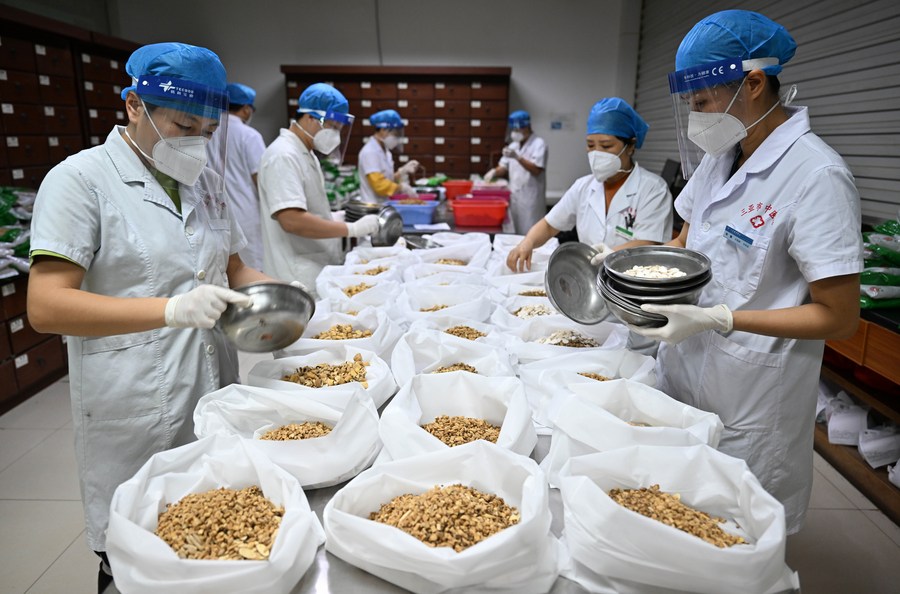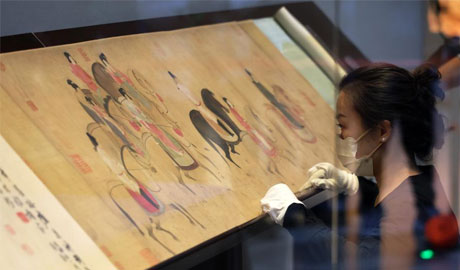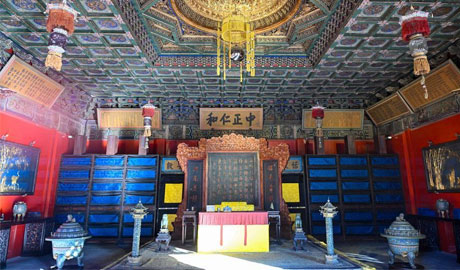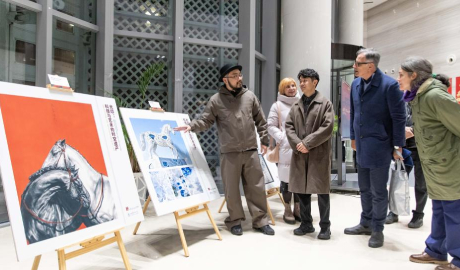


Pharmacists prepare Chinese herbal medicine at the Traditional Chinese Medicine Hospital of Sanya City in Sanya, south China's Hainan province, Aug. 20, 2022. (Xinhua/Guo Cheng)
BEIJING, Sept. 8 (Xinhua) -- Since the 18th National Congress of the Communist Party of China (CPC) in 2012, the central Party leadership has prioritized the people's health in a strategic move.
With deepened medical and healthcare system reform, China is now on track to a healthcare reform and development path with Chinese characteristics, according to a CPC press conference on China's progress in this regard over the past 10 years.
PROMOTION OF HEALTH SERVICE ACCESSIBILITY
The average life expectancy in China rose from 74.8 years to 78.2 years over the past decade. The latest statistics show that basic medical insurance schemes covered 1.36 billion people, or 96.45 percent of the total population, and the proportion of healthcare expenses borne by individuals dropped to 27.7 percent.
"As reform of the medical and healthcare systems intensifies, the problem of difficult and expensive access to medical treatment is being solved at a faster pace," said Li Bin, deputy head of the National Health Commission.
Generally speaking, Li added, the past decade has witnessed the most progress in China's health cause.
ACCELERATED DEVELOPMENT OF TCM SERVICE SYSTEM
Traditional Chinese Medicine (TCM) embodies the Chinese nation's concepts of health preservation and relevant practices throughout several millennia and is a national treasure.
Over the past decade, China has accelerated the construction of a high-quality and efficient TCM service system and significantly improved the capacity of community-based TCM services, making TCM services fairer, more accessible, and more convenient, according to officials.
Recent years saw steady efforts in pushing ahead with projects designed to build community-level TCM service capacity, noted Qin Huaijin, deputy head of the National Administration of Traditional Chinese Medicine.
Since 2012, the central government has provided funding support for constructing 36,700 TCM service centers. By the end of 2020, more than 80 percent of community-level and township-level health institutions had been equipped with TCM service centers.
State-level hospitals were mobilized to help and support nearly 700 county-level TCM hospitals in improving service capacity through pair-up assistance.
"TCM development over the past 10 years has been at its best since the founding of the People's Republic of China in 1949," Qin said.
IMPROVEMENT OF HEALTH EMERGENCY RESPONSE CAPACITY
In the last 10 years, China's public health system withstood the tests of H7N9 bird flu, Middle East respiratory syndrome, and COVID-19, as well as natural disasters such as earthquakes and floods.
China has basically established a health emergency response system with its core capacity in health emergency response reaching the advanced international level, and has responded rationally and efficiently to public health emergencies, noted Chang Jile, deputy head of the national administration of disease prevention and control.
"China has set up the world's largest direct reporting system of epidemics and public health emergencies, and the average reporting time has been shortened to four hours," said Chang.
China can identify more than 300 pathogens within 72 hours, he said.
In addition, China has established a public health emergency risk assessment system and 59 national health emergency teams in four categories, said Chang.

Ancient painting "Lady Guoguo's Spring Outing" to be displayed at Liaoning Provincial Museum

Lianyungang port welcomes largest group of S. Korean travelers under China's visa-free policy

Hall of Mental Cultivation of the Palace Museum reopens to public

Wuyi rock pigment painting in China's Fujian infuses modern artistic elements into tradition

China-Serbia digital art exhibition explores time, space, heritage
点击右上角![]() 微信好友
微信好友
 朋友圈
朋友圈

请使用浏览器分享功能进行分享
